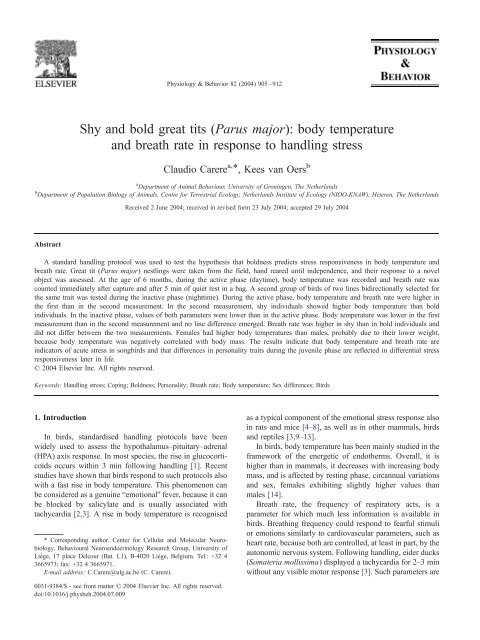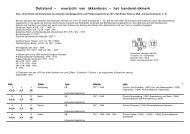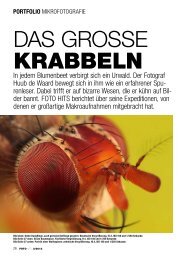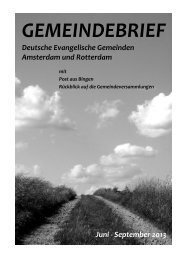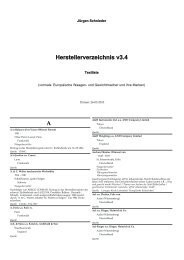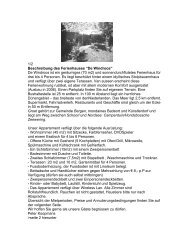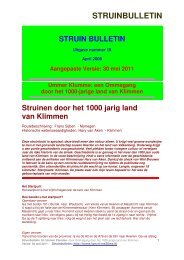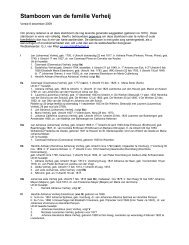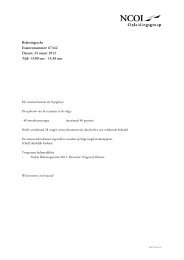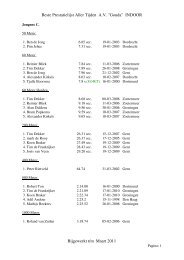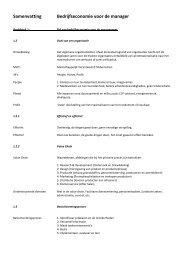body temperature and breath rate in response to handling stress
body temperature and breath rate in response to handling stress
body temperature and breath rate in response to handling stress
Create successful ePaper yourself
Turn your PDF publications into a flip-book with our unique Google optimized e-Paper software.
Physiology & Behavior 82 (2004) 905–912<br />
Shy <strong>and</strong> bold great tits (Parus major): <strong>body</strong> <strong>temperature</strong><br />
<strong>and</strong> <strong>breath</strong> <strong>rate</strong> <strong>in</strong> <strong>response</strong> <strong>to</strong> h<strong>and</strong>l<strong>in</strong>g <strong>stress</strong><br />
Claudio Carere a, *, Kees van Oers b<br />
a Department of Animal Behaviour, University of Gron<strong>in</strong>gen, The Netherl<strong>and</strong>s<br />
b Department of Population Biology of Animals, Centre for Terrestrial Ecology, Netherl<strong>and</strong>s Institute of Ecology (NIOO-KNAW), Heteren, The Netherl<strong>and</strong>s<br />
Received 2 June 2004; received <strong>in</strong> revised form 23 July 2004; accepted 29 July 2004<br />
Abstract<br />
A st<strong>and</strong>ard h<strong>and</strong>l<strong>in</strong>g pro<strong>to</strong>col was used <strong>to</strong> test the hypothesis that boldness predicts <strong>stress</strong> responsiveness <strong>in</strong> <strong>body</strong> <strong>temperature</strong> <strong>and</strong><br />
<strong>breath</strong> <strong>rate</strong>. Great tit (Parus major) nestl<strong>in</strong>gs were taken from the field, h<strong>and</strong> reared until <strong>in</strong>dependence, <strong>and</strong> their <strong>response</strong> <strong>to</strong> a novel<br />
object was assessed. At the age of 6 months, dur<strong>in</strong>g the active phase (daytime), <strong>body</strong> <strong>temperature</strong> was recorded <strong>and</strong> <strong>breath</strong> <strong>rate</strong> was<br />
counted immediately after capture <strong>and</strong> after 5 m<strong>in</strong> of quiet rest <strong>in</strong> a bag. A second group of birds of two l<strong>in</strong>es bidirectionally selected for<br />
the same trait was tested dur<strong>in</strong>g the <strong>in</strong>active phase (nighttime). Dur<strong>in</strong>g the active phase, <strong>body</strong> <strong>temperature</strong> <strong>and</strong> <strong>breath</strong> <strong>rate</strong> were higher <strong>in</strong><br />
the first than <strong>in</strong> the second measurement. In the second measurement, shy <strong>in</strong>dividuals showed higher <strong>body</strong> <strong>temperature</strong> than bold<br />
<strong>in</strong>dividuals. In the <strong>in</strong>active phase, values of both parameters were lower than <strong>in</strong> the active phase. Body <strong>temperature</strong> was lower <strong>in</strong> the first<br />
measurement than <strong>in</strong> the second measurement <strong>and</strong> no l<strong>in</strong>e difference emerged. Breath <strong>rate</strong> was higher <strong>in</strong> shy than <strong>in</strong> bold <strong>in</strong>dividuals <strong>and</strong><br />
did not differ between the two measurements. Females had higher <strong>body</strong> <strong>temperature</strong>s than males, probably due <strong>to</strong> their lower weight,<br />
because <strong>body</strong> <strong>temperature</strong> was negatively correlated with <strong>body</strong> mass. The results <strong>in</strong>dicate that <strong>body</strong> <strong>temperature</strong> <strong>and</strong> <strong>breath</strong> <strong>rate</strong> are<br />
<strong>in</strong>dica<strong>to</strong>rs of acute <strong>stress</strong> <strong>in</strong> songbirds <strong>and</strong> that differences <strong>in</strong> personality traits dur<strong>in</strong>g the juvenile phase are reflected <strong>in</strong> differential <strong>stress</strong><br />
responsiveness later <strong>in</strong> life.<br />
D 2004 Elsevier Inc. All rights reserved.<br />
Keywords: H<strong>and</strong>l<strong>in</strong>g <strong>stress</strong>; Cop<strong>in</strong>g; Boldness; Personality; Breath <strong>rate</strong>; Body <strong>temperature</strong>; Sex differences; Birds<br />
1. Introduction<br />
In birds, st<strong>and</strong>ardised h<strong>and</strong>l<strong>in</strong>g pro<strong>to</strong>cols have been<br />
widely used <strong>to</strong> assess the hypothalamus–pituitary–adrenal<br />
(HPA) axis <strong>response</strong>. In most species, the rise <strong>in</strong> glucocorticoids<br />
occurs with<strong>in</strong> 3 m<strong>in</strong> follow<strong>in</strong>g h<strong>and</strong>l<strong>in</strong>g [1]. Recent<br />
studies have shown that birds respond <strong>to</strong> such pro<strong>to</strong>cols also<br />
with a fast rise <strong>in</strong> <strong>body</strong> <strong>temperature</strong>. This phenomenon can<br />
be considered as a genu<strong>in</strong>e bemotionalQ fever, because it can<br />
be blocked by salicylate <strong>and</strong> is usually associated with<br />
tachycardia [2,3]. A rise <strong>in</strong> <strong>body</strong> <strong>temperature</strong> is recognised<br />
* Correspond<strong>in</strong>g author. Center for Cellular <strong>and</strong> Molecular Neurobiology,<br />
Behavioural Neuroendocr<strong>in</strong>ology Research Group, University of<br />
Liège, 17 place Delcour (Bat. L1), B-4020 Liège, Belgium. Tel.: +32 4<br />
3665973; fax: +32 4 3665971.<br />
E-mail address: C.Carere@ulg.ac.be (C. Carere).<br />
as a typical component of the emotional <strong>stress</strong> <strong>response</strong> also<br />
<strong>in</strong> rats <strong>and</strong> mice [4–8], as well as <strong>in</strong> other mammals, birds<br />
<strong>and</strong> reptiles [3,9–13].<br />
In birds, <strong>body</strong> <strong>temperature</strong> has been ma<strong>in</strong>ly studied <strong>in</strong> the<br />
framework of the energetic of endotherms. Overall, it is<br />
higher than <strong>in</strong> mammals, it decreases with <strong>in</strong>creas<strong>in</strong>g <strong>body</strong><br />
mass, <strong>and</strong> is affected by rest<strong>in</strong>g phase, circannual variations<br />
<strong>and</strong> sex, females exhibit<strong>in</strong>g slightly higher values than<br />
males [14].<br />
Breath <strong>rate</strong>, the frequency of respira<strong>to</strong>ry acts, is a<br />
parameter for which much less <strong>in</strong>formation is available <strong>in</strong><br />
birds. Breath<strong>in</strong>g frequency could respond <strong>to</strong> fearful stimuli<br />
or emotions similarly <strong>to</strong> cardiovascular parameters, such as<br />
heart <strong>rate</strong>, because both are controlled, at least <strong>in</strong> part, by the<br />
au<strong>to</strong>nomic nervous system. Follow<strong>in</strong>g h<strong>and</strong>l<strong>in</strong>g, eider ducks<br />
(Somateria mollissima) displayed a tachycardia for 2–3 m<strong>in</strong><br />
without any visible mo<strong>to</strong>r <strong>response</strong> [3]. Such parameters are<br />
0031-9384/$ - see front matter D 2004 Elsevier Inc. All rights reserved.<br />
doi:10.1016/j.physbeh.2004.07.009
906<br />
C. Carere, K. van Oers / Physiology & Behavior 82 (2004) 905–912<br />
<strong>in</strong>dex of the emotional <strong>and</strong> <strong>stress</strong> <strong>response</strong> [8], but are<br />
difficult <strong>to</strong> obta<strong>in</strong> <strong>in</strong> a small songbird. Recently, <strong>breath</strong> <strong>rate</strong><br />
has been counted <strong>in</strong> great tits about 18 h follow<strong>in</strong>g social<br />
defeat (Parus major), but no effect was detected, probably<br />
because an <strong>in</strong>creased activity of the adrenergic system<br />
occurs only <strong>in</strong> the very short term follow<strong>in</strong>g exposure <strong>to</strong> a<br />
<strong>stress</strong>ful stimulus [12].<br />
Individuals differ nonr<strong>and</strong>omly <strong>in</strong> the way they deal with<br />
<strong>stress</strong>ors <strong>and</strong> novelties <strong>and</strong> appear <strong>to</strong> vary along a<br />
behavioural cont<strong>in</strong>uum from shy <strong>to</strong> bold [15–17]. These<br />
differences covary with other behavioural traits, such as<br />
aggression, exploration, risk tak<strong>in</strong>g, fearfulness <strong>and</strong> reactivity:<br />
for example, bold <strong>and</strong> less fearful <strong>in</strong>dividuals are<br />
more aggressive than shy <strong>and</strong> fearful <strong>in</strong>dividuals [18–24].<br />
Several l<strong>in</strong>es of evidence, <strong>in</strong>clud<strong>in</strong>g selection l<strong>in</strong>es experiments,<br />
suggest that these differences are aspects of a<br />
coherent <strong>and</strong> heritable behavioural organization ma<strong>in</strong>ta<strong>in</strong>ed<br />
by natural selection [21–25]. Such <strong>in</strong>dividual behavioural<br />
organizations are referred <strong>to</strong> as behavioural syndromes,<br />
predispositions, profiles, cop<strong>in</strong>g styles, st<strong>rate</strong>gies, <strong>and</strong> axes<br />
[26,27], comparable <strong>to</strong> human personalities [28]. In rodents,<br />
proactive personalities (bold, bactiveQ <strong>and</strong> aggressive<br />
animals) are associated with high neurosympathetic activity<br />
<strong>and</strong> low HPA reactivity, whereas reactive personalities (shy,<br />
bpassiveQ <strong>and</strong> less aggressive animals) are associated with<br />
high cardiac parasympathetic activity <strong>and</strong> high HPA<br />
reactivity [21,22,29,30].<br />
In the great tit (P. major), a small passer<strong>in</strong>e bird, many<br />
<strong>in</strong>dividuals show extreme phenotypes with<strong>in</strong> a given<br />
population, be<strong>in</strong>g bfastQ (or bold) or bslowQ (or shy) <strong>in</strong><br />
exploration tasks, <strong>in</strong>clud<strong>in</strong>g novelty <strong>response</strong>s [15]. Recent<br />
studies demonst<strong>rate</strong> the presence of considerable amount of<br />
both additive genetic variation <strong>and</strong> dom<strong>in</strong>ance genetic<br />
variation of such personality traits <strong>in</strong> wild great tit<br />
populations [31] <strong>and</strong> selection l<strong>in</strong>es experiments have<br />
shown high heritability for early explora<strong>to</strong>ry behaviour<br />
based on four generations of artificial selection [23]. These<br />
trait characteristics are relatively stable across age [23].<br />
They correlate both phenotypically <strong>and</strong> genetically with<br />
differences <strong>in</strong> aggression [19,24,32], forag<strong>in</strong>g behaviour<br />
[15,33], <strong>response</strong> <strong>to</strong> social <strong>stress</strong> <strong>and</strong> risk-tak<strong>in</strong>g behaviour<br />
[12,34–36]. Therefore, they may <strong>in</strong>deed reflect personalities<br />
[27,36]. The l<strong>in</strong>es show resemblance <strong>to</strong> selection l<strong>in</strong>es<br />
established from wild house mice populations [18,24,27].<br />
This resemblance <strong>in</strong>cludes also physiological parameters<br />
<strong>in</strong>volved <strong>in</strong> the <strong>stress</strong> <strong>response</strong>: the great tit data on <strong>breath</strong><br />
<strong>rate</strong> <strong>in</strong>dicate a trend for higher levels <strong>in</strong> the l<strong>in</strong>e of slow<br />
<strong>in</strong>dividuals [12], while data on the adrenocortical <strong>response</strong><br />
<strong>in</strong>dicate higher HPA reactivity <strong>in</strong> the same l<strong>in</strong>e [35]. The<br />
great tit l<strong>in</strong>es also resemble two l<strong>in</strong>es of leghorns orig<strong>in</strong>ally<br />
selected for productivity traits, the so-called high feather<br />
peck<strong>in</strong>g frequency (HP) <strong>and</strong> low feather peck<strong>in</strong>g frequency<br />
(LP) l<strong>in</strong>es [27]. Hens of the LP l<strong>in</strong>e, that resemble shy great<br />
tits, had higher basal <strong>and</strong> <strong>stress</strong>-<strong>in</strong>duced (manual restra<strong>in</strong>t)<br />
plasma corticosterone levels than hens of the HP l<strong>in</strong>e, that<br />
resemble the bold great tits [37,38]. Hens of the LP l<strong>in</strong>e also<br />
showed higher parasympathetic <strong>response</strong> than birds of the<br />
high feather peck<strong>in</strong>g l<strong>in</strong>e [39].<br />
This study was designed <strong>to</strong> test how great tits different<br />
for shyness <strong>and</strong> boldness respond physiologically (<strong>body</strong><br />
<strong>temperature</strong> <strong>and</strong> <strong>breath</strong> <strong>rate</strong>) <strong>to</strong> an unpredictable <strong>and</strong> acute<br />
<strong>stress</strong>ful event (capture <strong>and</strong> h<strong>and</strong>l<strong>in</strong>g). We tested two<br />
<strong>in</strong>dependent groups, one dur<strong>in</strong>g daytime (active phase)<br />
<strong>and</strong> one dur<strong>in</strong>g nighttime (<strong>in</strong>active phase). The nighttime<br />
group was tested primarily <strong>in</strong> an attempt <strong>to</strong> record m<strong>in</strong>imum<br />
rest<strong>in</strong>g levels. We hypothesised that shy <strong>in</strong>dividuals show<br />
higher or more prolonged <strong>response</strong>s than bold <strong>in</strong>dividuals <strong>in</strong><br />
both parameters [10,12,21,30,39].<br />
2. Methods<br />
2.1. Subjects <strong>and</strong> hous<strong>in</strong>g<br />
The great tit is a terri<strong>to</strong>rial, nonmigra<strong>to</strong>ry passer<strong>in</strong>e bird<br />
(<strong>body</strong> mass: 16–20 g) <strong>in</strong>habit<strong>in</strong>g woods <strong>and</strong> parks. The<br />
group of birds tested dur<strong>in</strong>g the active phase consisted<br />
orig<strong>in</strong>ally of 90 chicks collected from a wild population at<br />
the age of 10 days <strong>in</strong> May–June <strong>and</strong> h<strong>and</strong> reared under<br />
st<strong>and</strong>ard conditions until <strong>in</strong>dependence [15]. From <strong>in</strong>dependence<br />
onwards (days 25–30 after hatch<strong>in</strong>g), birds were<br />
housed <strong>in</strong>dividually <strong>in</strong> st<strong>and</strong>ard cages of 0.90.40.5 m<br />
with a wooden bot<strong>to</strong>m, <strong>to</strong>p, sides <strong>and</strong> rear walls, a wiremesh<br />
front <strong>and</strong> three perches. They were kept under natural<br />
light conditions (LD 10:14 h dur<strong>in</strong>g the period of the <strong>stress</strong><br />
pro<strong>to</strong>col, December 1998), <strong>and</strong> had audi<strong>to</strong>ry <strong>and</strong> visual<br />
contact with other <strong>in</strong>dividuals housed <strong>in</strong> the same room.<br />
Food (commercial seed mixture, sunflowers <strong>and</strong> a prote<strong>in</strong><br />
rich mixture supplemented daily with mealworms, Tenebrio<br />
moli<strong>to</strong>r) <strong>and</strong> water were provided ad libitum.<br />
The birds tested dur<strong>in</strong>g the <strong>in</strong>active phase were 16 adult<br />
male great tits (2–3 years old) orig<strong>in</strong>at<strong>in</strong>g from a program of<br />
bidirectional artificial selection started <strong>in</strong> 1993 on the basis<br />
of the outcome of exploration tests carried out at the age of<br />
30–40 days [23]. L<strong>in</strong>es did not differ <strong>in</strong> <strong>body</strong> mass or tarsus<br />
length. The birds belonged <strong>to</strong> the third <strong>and</strong> fourth<br />
generation, 6 of the Slow (shy) <strong>and</strong> 10 of the Fast (bold)<br />
l<strong>in</strong>e. They were housed <strong>and</strong> ma<strong>in</strong>ta<strong>in</strong>ed as described above.<br />
Birds were sexed with molecular markers [40]. Body<br />
mass <strong>and</strong> other morphometric measurements were taken<br />
about 2 weeks before the <strong>stress</strong> pro<strong>to</strong>col.<br />
2.2. Novel object tests<br />
Two tests were carried out at the age of 35–40 days after<br />
hatch<strong>in</strong>g, <strong>in</strong>troduc<strong>in</strong>g a novel object on one of the outer<br />
perches. A penlight battery was used on the first day <strong>and</strong> an<br />
8-cm p<strong>in</strong>k rubber <strong>to</strong>y on the second day. Birds were<br />
characterized for shyness <strong>and</strong> boldness assess<strong>in</strong>g their<br />
latency <strong>to</strong> approach the object <strong>and</strong> the shortest distance <strong>to</strong><br />
it with<strong>in</strong> 120 s. The results for each test were converted<br />
l<strong>in</strong>early <strong>to</strong> a 0–5 scale. A score of 5 was given when the bird
C. Carere, K. van Oers / Physiology & Behavior 82 (2004) 905–912 907<br />
pecked the object <strong>and</strong> a score of 0 was given when the bird<br />
did not l<strong>and</strong> on the perch with the object [15,23]. The sum<br />
of the test scores, rang<strong>in</strong>g from 0 <strong>to</strong> 10 is the shyness–<br />
boldness trait. We categorised as bshyQ all <strong>in</strong>dividuals with<br />
scores from 0 <strong>to</strong> 3 (<strong>in</strong>cluded) <strong>and</strong> bboldQ all <strong>in</strong>dividuals with<br />
scores from 6 (<strong>in</strong>cluded) <strong>to</strong> 10. Twenty-n<strong>in</strong>e birds match<strong>in</strong>g<br />
these criteria were selected for the experiment (14 bboldQ,15<br />
bshyQ <strong>in</strong>dividuals; mean scoreFS.E.M.=7.3F0.4 <strong>and</strong><br />
0.9F0.3; Mann–Whitney U-test z= 4.7, pb0.001). The<br />
birds of the selection l<strong>in</strong>es were tested <strong>in</strong> the same way <strong>to</strong><br />
check for the l<strong>in</strong>e difference <strong>in</strong> the juvenile phase (fast l<strong>in</strong>e<br />
mean scoreFS.E.M.=7.3F0.5; slow l<strong>in</strong>e=0.0F0.0, z= 3.3,<br />
pb0.01) <strong>and</strong> <strong>in</strong> adulthood (fast l<strong>in</strong>e mean scoreFS.E.M.=<br />
7.8F0.7; slow l<strong>in</strong>e=3.4F1.3; z= 2.35, p=0.02).<br />
2.3. H<strong>and</strong>l<strong>in</strong>g <strong>stress</strong> pro<strong>to</strong>col <strong>and</strong> physiological<br />
measurements<br />
The adult males of the selection l<strong>in</strong>es were tested dur<strong>in</strong>g<br />
the <strong>in</strong>active phase at the end of the dark period, between 0630<br />
<strong>and</strong> 0730 h. The other group of birds was tested dur<strong>in</strong>g the<br />
active phase between 0900 <strong>and</strong> 1200 h. Each bird was tested<br />
accord<strong>in</strong>g <strong>to</strong> the follow<strong>in</strong>g procedure: first, the subject was<br />
chased <strong>in</strong> its home cage <strong>and</strong> the time was measured from the<br />
moment the cage was entered with the right h<strong>and</strong> until the<br />
bird was caught (catch<strong>in</strong>g time). This time scored zero dur<strong>in</strong>g<br />
the <strong>in</strong>active phase, because birds were caught <strong>in</strong> the darkness<br />
<strong>and</strong> care was taken <strong>to</strong> avoid wak<strong>in</strong>g them up. After capture,<br />
one of two physiological parameters, either <strong>body</strong> <strong>temperature</strong><br />
(T1) or <strong>breath</strong> <strong>rate</strong> (B1), was measured immediately; afterwards,<br />
the bird was put <strong>in</strong> a cot<strong>to</strong>n bag hang<strong>in</strong>g apart <strong>and</strong> a<br />
second measurement of the same parameter was taken after 5<br />
m<strong>in</strong> (T2, B2). After the second measurement, the bird was<br />
released <strong>in</strong> its home cage. Sixty m<strong>in</strong>utes later, the same<br />
procedure was used <strong>to</strong> measure the second physiological<br />
parameter. The assignment of which of the two parameters<br />
was measured first was r<strong>and</strong>om. In the birds tested dur<strong>in</strong>g the<br />
<strong>in</strong>active phase, <strong>breath</strong> <strong>rate</strong> was measured immediately after<br />
(i.e., few seconds) <strong>body</strong> <strong>temperature</strong>.<br />
Body <strong>temperature</strong> was measured with a thermometric<br />
probe (AMR Therm—30+100 NTC TYP C 2244-1,<br />
AHLBORN Mess-und Regelungstechnik D-8150 HOLZ-<br />
KIRCHEN—P.O.B 12 60, Germany) constantly kept <strong>in</strong><br />
warm water (30–35 8C). The probe was <strong>in</strong>serted <strong>in</strong> the<br />
cloaca for 10 mm. It <strong>to</strong>ok approximately 5–10 s, until the<br />
value on the display became stable. Breath <strong>rate</strong> was<br />
obta<strong>in</strong>ed by count<strong>in</strong>g the breast movements dur<strong>in</strong>g 60 s<br />
while firmly keep<strong>in</strong>g the bird <strong>in</strong> the h<strong>and</strong>. Body mass was<br />
measured with an electronic balance <strong>to</strong> the nearest 0.1 g<br />
<strong>and</strong> tarsus with slid<strong>in</strong>g calipers <strong>to</strong> the nearest 0.1 mm 2<br />
weeks before the tests.<br />
2.4. Data analysis<br />
Correlational analysis (Spearman correlation coefficient)<br />
was used <strong>to</strong> explore the association between catch<strong>in</strong>g time,<br />
<strong>body</strong> mass, <strong>body</strong> <strong>temperature</strong> <strong>and</strong> <strong>breath</strong> <strong>rate</strong>. To test if sex<br />
or type affected catch<strong>in</strong>g time, univariate analysis of<br />
variance with the two variables as fixed fac<strong>to</strong>rs <strong>in</strong>clud<strong>in</strong>g<br />
their <strong>in</strong>teraction was run with <strong>body</strong> <strong>temperature</strong> or <strong>breath</strong><br />
<strong>rate</strong> as dependent variables. A similar analysis was run <strong>to</strong><br />
check the effect of sex <strong>and</strong> type on <strong>body</strong> mass. For the<br />
analysis of the <strong>stress</strong> <strong>response</strong> <strong>in</strong> relation <strong>to</strong> type (shy <strong>and</strong><br />
bold), sex <strong>and</strong> sampl<strong>in</strong>g time (first <strong>and</strong> second measurement),<br />
we used parametric fac<strong>to</strong>rial analysis of variance<br />
consider<strong>in</strong>g type <strong>and</strong> sex as group<strong>in</strong>g fac<strong>to</strong>r <strong>and</strong> sampl<strong>in</strong>g<br />
time as repeated-measure fac<strong>to</strong>r (two levels). Variance was<br />
homogeneous across the four subgroups. Multiple comparisons<br />
for the variable type, sepa<strong>rate</strong>ly for the two sampl<strong>in</strong>g<br />
times, were performed by Tukey–Kramer least significant<br />
difference (LSD) test. The use of this test is recommended<br />
even <strong>in</strong> the absence of significant ma<strong>in</strong> or <strong>in</strong>teraction effects<br />
<strong>in</strong> the analysis of variance [41], because the procedure<br />
protects from the <strong>in</strong>creased probability of type I errors due<br />
<strong>to</strong> the repeated measure. An overall model pool<strong>in</strong>g the two<br />
groups of birds was run <strong>to</strong> test the effect of activity period.<br />
When necessary, data were normalized by log transformation<br />
prior <strong>to</strong> the parametric analyses. All tests were two<br />
tailed. Significance level was a=0.05.<br />
3. Results<br />
3.1. Active phase<br />
Males were significantly heavier than females [means<br />
<strong>and</strong> st<strong>and</strong>ard errors: 19.34F0.23 vs. 18.18F0.17 g, respectively,<br />
F(1,25)=5.7, pb0.004] <strong>and</strong> no effect of type<br />
[ F(1,25)=0.003, p=0.96] or its <strong>in</strong>teraction with sex<br />
[ F(1,25)=1.2, p=0.29] were found. No sex effects were<br />
found <strong>in</strong> the novel object tests [sex, F(1,25)=1.8, p=0.19;<br />
sextype, F(1,25)=1.4, p=0.25].<br />
In the <strong>body</strong> <strong>temperature</strong> session, catch<strong>in</strong>g time ranged<br />
between 4 <strong>and</strong> 55 s (mean: 21.8F14.5 s), but it did not<br />
correlate with any of the two measurements (Table 1), <strong>and</strong><br />
did not differ <strong>in</strong> relation <strong>to</strong> type [ F(1,25)=0.9, p=0.35] or<br />
sex [ F(1,25)=0.41, p=0.53]. Comput<strong>in</strong>g the correlation<br />
Table 1<br />
Association (Spearman correlation coefficient) between the variables<br />
catch<strong>in</strong>g time (CtT: <strong>body</strong> <strong>temperature</strong> session; CtB: <strong>breath</strong> <strong>rate</strong> session),<br />
<strong>body</strong> <strong>temperature</strong> (T1: first measurement; T2: second measurement) <strong>and</strong><br />
<strong>breath</strong> <strong>rate</strong> dur<strong>in</strong>g the active phase (B1: first measurement; B2: second<br />
measurement)<br />
CtT CtB T1 T2 B1<br />
CtB 0.38*<br />
T1 0.16 0.15<br />
T2 0.04 0.20 0.74**<br />
B1 0.32 0.21 0.19 0.24<br />
B2 0.13 0.07 0.11 0.12 0.41*<br />
N=29.<br />
* pb0.05.<br />
** pb0.01.
908<br />
C. Carere, K. van Oers / Physiology & Behavior 82 (2004) 905–912<br />
sepa<strong>rate</strong>ly for the two l<strong>in</strong>es yielded similar results. In the<br />
<strong>breath</strong> <strong>rate</strong> session, it <strong>to</strong>ok significantly less time <strong>to</strong> catch a<br />
bird than <strong>in</strong> the <strong>body</strong> <strong>temperature</strong> session [ F(1,56)=5.3<br />
pb0.01], values rang<strong>in</strong>g between 4 <strong>and</strong> 40 s (mean:<br />
11.9F9.4 s). Catch<strong>in</strong>g time <strong>in</strong> the <strong>breath</strong> <strong>rate</strong> session did<br />
not differ <strong>in</strong> relation <strong>to</strong> type [ F(1,25)=0.01, p=0.92] or sex<br />
[ F(1,25)=0.05, p=0.82] <strong>and</strong> did not correlate with any of<br />
the two measurements (Table 1). No significant correlation<br />
was found between <strong>body</strong> <strong>temperature</strong> <strong>and</strong> <strong>breath</strong> <strong>rate</strong> <strong>in</strong> any<br />
of the two measurements, whereas first <strong>and</strong> second<br />
measurements showed a positive correlation <strong>in</strong> both<br />
parameters (Table 1).<br />
Body <strong>temperature</strong> was significantly higher <strong>in</strong> the first<br />
measurement than <strong>in</strong> the second one [sampl<strong>in</strong>g time,<br />
F(1,25)=23.9, pb0.01, Figs. 1a <strong>and</strong> 2a]. No overall effect<br />
of type was evident [ F(1,25)=1.1, p=0.29]. In shy<br />
<strong>in</strong>dividuals, the decrease <strong>in</strong> <strong>body</strong> <strong>temperature</strong> <strong>in</strong> the second<br />
measurement was less marked than <strong>in</strong> bold <strong>in</strong>dividuals<br />
[typesampl<strong>in</strong>g time, F(1,25)=3.7, p=0.06, but pb0.05 <strong>in</strong><br />
Tukey–Kramer LSD test <strong>in</strong> the second measurement, Fig.<br />
1a]. Females had higher <strong>temperature</strong>s than males <strong>in</strong> both<br />
measurements [sex, F(1,25)=7.9, p=0.01, Fig. 2a] by about<br />
Fig. 2. Body <strong>temperature</strong> (a) <strong>and</strong> <strong>breath</strong> <strong>rate</strong> (b) <strong>in</strong> male <strong>and</strong> female great tits<br />
immediately after capture (T1, B1) <strong>and</strong> after 5 m<strong>in</strong> (T2, B2) dur<strong>in</strong>g the<br />
active phase. Values are means+S.E.M. **pb0.01.<br />
Fig. 1. Body <strong>temperature</strong> (a) <strong>and</strong> <strong>breath</strong> <strong>rate</strong> (b) <strong>in</strong> shy <strong>and</strong> bold great tits<br />
immediately after capture (T1, B1) <strong>and</strong> after 5 m<strong>in</strong> (T2, B2) dur<strong>in</strong>g the<br />
<strong>in</strong>active <strong>and</strong> the active phases. Values are means+S.E.M. *pb0.05;<br />
**pb0.01.<br />
0.8 8C. No significant <strong>in</strong>teraction between sex <strong>and</strong> sampl<strong>in</strong>g<br />
time [ F(1,25)=0.01 p=0.97] or between sex <strong>and</strong> type<br />
[ F(1,25)=0.28, p=0.60] emerged.<br />
Breath <strong>rate</strong> was also significantly higher <strong>in</strong> the first<br />
measurement than <strong>in</strong> the second one [ F(1,25)=4.3, pb0.05,<br />
Figs. 1b <strong>and</strong> 2b]. No ma<strong>in</strong> effect or <strong>in</strong>teraction of type with<br />
sampl<strong>in</strong>g time [ F(1,25)=1.1 p=0.31, F(1,25)=0.22, p=0.64,<br />
respectively] was found. Although male birds showed a<br />
more marked decrease <strong>in</strong> the second measurement, neither a<br />
sex difference [ F(1,25)=1.8, p=0.19, pN0.05 <strong>in</strong> Tukey–<br />
Kramer LSD test <strong>in</strong> the second measurement] nor the<br />
<strong>in</strong>teraction between sex <strong>and</strong> sampl<strong>in</strong>g time [ F(1,25)=2.3<br />
p=0.14] was significant (Fig. 2b).<br />
The effect of sex on <strong>body</strong> <strong>temperature</strong> disappeared<br />
[ F(1,24)=1.5, p=0.23] when <strong>body</strong> mass was <strong>in</strong>troduced <strong>in</strong><br />
the model of the analysis of variance as a covariate<br />
[ F(1,24)=2.9, p=0.09], <strong>in</strong>dicat<strong>in</strong>g that <strong>body</strong> mass could<br />
expla<strong>in</strong> the sex difference. In fact, <strong>body</strong> mass showed a<br />
significant negative association with <strong>body</strong> <strong>temperature</strong> <strong>in</strong><br />
both measurements (r s = 0.44, p=0.02; r s = 0.64, pb0.001,<br />
n=29 for first <strong>and</strong> second measurements, not shown), but<br />
not with <strong>breath</strong> <strong>rate</strong> (r s = 0.19, p=0.32; r s =0.15, p=0.43,<br />
n=29 for first <strong>and</strong> second measurements, not shown). When
C. Carere, K. van Oers / Physiology & Behavior 82 (2004) 905–912 909<br />
the association of <strong>body</strong> mass with <strong>body</strong> <strong>temperature</strong> was<br />
tested sepa<strong>rate</strong>ly for the sexes, a significant negative<br />
correlation <strong>in</strong> both measurements was present <strong>in</strong> females<br />
(r s = 0.54, p=0.02; r s = 0.63, p=0.004, n=19 for first <strong>and</strong><br />
second measurements, Fig. 3a), but not <strong>in</strong> males (r s =0.45,<br />
p=0.19; r s = 0.08, p=0.82, n=10, for first <strong>and</strong> second<br />
measurements, Fig. 3b). This latter result was likely due <strong>to</strong><br />
the presence of an outlier show<strong>in</strong>g very low values <strong>in</strong> both<br />
measurements <strong>to</strong>gether with the lower sample size <strong>in</strong> males<br />
(Fig. 3b).<br />
3.2. Inactive phase<br />
Body <strong>temperature</strong> was significantly higher <strong>in</strong> the second<br />
measurement than <strong>in</strong> the first one [sampl<strong>in</strong>g time,<br />
F(1,14)=9.0, pb0.01, Fig. 1a]. No effect of type or its<br />
<strong>in</strong>teraction with sampl<strong>in</strong>g time was evident [ F(1,14)=0.43,<br />
p=0.52; F(1,14)=0.08, p=0.77, respectively]. Breath <strong>rate</strong><br />
did not differ between the two measurements [sampl<strong>in</strong>g<br />
time, F(1,14)=2.4, p=0.14, Fig. 1b]. No ma<strong>in</strong> effect of type<br />
Fig. 3. Body <strong>temperature</strong> as a function of <strong>body</strong> mass <strong>in</strong> females (a) <strong>and</strong><br />
males (b) immediately after capture (T1) <strong>and</strong> after 5 m<strong>in</strong> (T2) dur<strong>in</strong>g the<br />
active phase.<br />
or its <strong>in</strong>teraction with sampl<strong>in</strong>g time was found, but shy<br />
birds tended <strong>to</strong> have higher <strong>breath</strong> <strong>rate</strong> than bold birds [type,<br />
F(1,14)=3.5, p=0.08; typesampl<strong>in</strong>g time, F(1,14)=2.4,<br />
p=0.14, respectively].<br />
Pool<strong>in</strong>g <strong>in</strong> one model the groups tested <strong>in</strong> the two activity<br />
phases revealed a significant effect of activity period <strong>in</strong> both<br />
parameters [ F(1,41)=109.2, pb0.001 for <strong>body</strong> <strong>temperature</strong>;<br />
F(1,41)=10.6, pb0.01 for <strong>breath</strong> <strong>rate</strong>, Fig. 1a <strong>and</strong> b], <strong>and</strong> a<br />
significant <strong>in</strong>teraction with sampl<strong>in</strong>g time for <strong>body</strong> <strong>temperature</strong><br />
only [ F(1,41)=32.9, pb0.001]: overall, values were<br />
higher dur<strong>in</strong>g the active period, <strong>and</strong> for <strong>body</strong> <strong>temperature</strong>,<br />
the patterns were opposite (Fig. 1a). A ma<strong>in</strong> effect of type<br />
was evident for <strong>breath</strong> <strong>rate</strong> [ F(1,41)=4.3, pb0.05, Fig. 1b]:<br />
shy birds displayed higher values than bold birds.<br />
4. Discussion<br />
4.1. Response <strong>to</strong> h<strong>and</strong>l<strong>in</strong>g <strong>stress</strong> <strong>in</strong> the <strong>in</strong>active <strong>and</strong> the<br />
active phase<br />
Dur<strong>in</strong>g the activity phase, catch<strong>in</strong>g <strong>and</strong> h<strong>and</strong>l<strong>in</strong>g has<br />
produced a pattern <strong>in</strong> which both <strong>body</strong> <strong>temperature</strong> <strong>and</strong><br />
<strong>breath</strong> <strong>rate</strong> decreased with time. Values were higher <strong>in</strong> the<br />
first measurement, immediately after capture, than 5 m<strong>in</strong><br />
later, when birds had been kept <strong>in</strong> a bag. Dur<strong>in</strong>g the <strong>in</strong>active<br />
phase, when birds were caught dur<strong>in</strong>g sleep, the pattern was<br />
opposite for <strong>body</strong> <strong>temperature</strong>, with values <strong>in</strong>creas<strong>in</strong>g with<br />
time. No difference between the first <strong>and</strong> second measurements<br />
was found for <strong>breath</strong> <strong>rate</strong>. Both parameters had higher<br />
values dur<strong>in</strong>g the active than dur<strong>in</strong>g the <strong>in</strong>active period. The<br />
comparison between the phases suggests that dur<strong>in</strong>g the<br />
active phase, at least for <strong>body</strong> <strong>temperature</strong>, the first<br />
measurement represents a <strong>stress</strong>-<strong>in</strong>duced rise <strong>and</strong> the<br />
decrease observed after 5 m<strong>in</strong> represents the tendency <strong>to</strong><br />
return <strong>to</strong> normal (activity) levels. It could be that catch<strong>in</strong>g<br />
time dur<strong>in</strong>g the light phase affects more <strong>breath</strong> <strong>rate</strong> than<br />
<strong>body</strong> <strong>temperature</strong>, as suggested by its borderl<strong>in</strong>e significant<br />
correlation with the first measurement. Interest<strong>in</strong>gly, the<br />
association with catch<strong>in</strong>g time was always negative, i.e.,<br />
shorter times correspond<strong>in</strong>g <strong>to</strong> higher <strong>breath</strong> <strong>rate</strong>s, like if a<br />
sudden fearful episode is more effective than the same<br />
<strong>stress</strong>or act<strong>in</strong>g for a more prolonged time (Table 1). The<br />
overall higher <strong>body</strong> <strong>temperature</strong> dur<strong>in</strong>g the active phase is<br />
not surpris<strong>in</strong>g, because the thermostat biological set-po<strong>in</strong>t<br />
oscillates through the nychtemeron [14].<br />
The rise <strong>in</strong> <strong>body</strong> <strong>temperature</strong> <strong>in</strong> the active phase could be<br />
due <strong>to</strong> <strong>stress</strong>-<strong>in</strong>duced hyperthermia, a phenomenon<br />
described <strong>in</strong> other animal species [5–7]. Catch<strong>in</strong>g the bird<br />
<strong>and</strong> measur<strong>in</strong>g cloacal <strong>temperature</strong> acted as a <strong>stress</strong>or <strong>and</strong><br />
elicited a very rapid hyperthermic <strong>response</strong>. In s<strong>in</strong>gly<br />
housed mice, 80% of the maximal hyperthermic <strong>response</strong><br />
can be reached with<strong>in</strong> 5 m<strong>in</strong> from the start of the <strong>stress</strong> [7].<br />
In our case, the mo<strong>to</strong>r load due <strong>to</strong> the <strong>in</strong>creased activity of<br />
the birds attempt<strong>in</strong>g <strong>to</strong> escape from be<strong>in</strong>g captured could<br />
have <strong>in</strong>duced thermogenesis, because the birds first had a
910<br />
C. Carere, K. van Oers / Physiology & Behavior 82 (2004) 905–912<br />
high <strong>temperature</strong> (hyperthermia) <strong>in</strong> T1 <strong>and</strong> then a lower<br />
value <strong>in</strong> T2, but still had a high <strong>temperature</strong> (emotional<br />
fever). However, no correlation was found between catch<strong>in</strong>g<br />
time <strong>and</strong> <strong>body</strong> <strong>temperature</strong>, but we cannot exclude the fact<br />
that it did enhance it or its rapidity. It must be noted that (i)<br />
it <strong>to</strong>ok less than 15 s <strong>to</strong> catch 14 out of 29 birds, a short time<br />
<strong>to</strong> allow a substantial hyperactivity able <strong>to</strong> produce thermogenesis<br />
<strong>and</strong> (ii) the behaviour of the birds before be<strong>in</strong>g<br />
caught was variable: some birds were try<strong>in</strong>g <strong>to</strong> flee, whereas<br />
others were freez<strong>in</strong>g or rema<strong>in</strong><strong>in</strong>g immobile <strong>in</strong> a corner of<br />
the cage. Unfortunately, we did not record these <strong>in</strong>dividual<br />
<strong>response</strong>s <strong>in</strong> detail, but taken <strong>to</strong>gether, these po<strong>in</strong>ts may<br />
expla<strong>in</strong> the lack of a significant correlation. In eider ducks<br />
h<strong>and</strong>led without chas<strong>in</strong>g, cloacal <strong>temperature</strong> <strong>in</strong>creased<br />
sharply with<strong>in</strong> 4 m<strong>in</strong> [3]. Anticipa<strong>to</strong>ry fear for an aversive<br />
event [7] could also play a role, as it was hypothesised for<br />
farm m<strong>in</strong>ks show<strong>in</strong>g very high values <strong>in</strong> their first<br />
measurements [10].<br />
The <strong>in</strong>crease <strong>in</strong> <strong>body</strong> <strong>temperature</strong> may be also due <strong>to</strong><br />
emotional fever. Emotional fever has been shown <strong>to</strong> occur<br />
<strong>in</strong> birds, as well as <strong>in</strong> reptiles, <strong>in</strong> <strong>response</strong> <strong>to</strong> gentle h<strong>and</strong>l<strong>in</strong>g<br />
<strong>and</strong> manual restra<strong>in</strong>t [4,5]. However, given our design, it is<br />
not possible <strong>to</strong> dist<strong>in</strong>guish between a genu<strong>in</strong>e fever,<br />
bwantedQ by the thermostat <strong>and</strong> characterized by an upward<br />
shift of the set-po<strong>in</strong>t <strong>temperature</strong>, <strong>and</strong> hyperthermia,<br />
characterized by a rise <strong>in</strong> central <strong>temperature</strong> above the<br />
set-po<strong>in</strong>t <strong>temperature</strong> due <strong>to</strong> an <strong>in</strong>crease <strong>in</strong> heat load [4].<br />
The rise <strong>in</strong> <strong>body</strong> <strong>temperature</strong> <strong>in</strong> the <strong>in</strong>active phase could<br />
be due <strong>to</strong> the transition from rest<strong>in</strong>g <strong>to</strong> activity levels rather<br />
than <strong>stress</strong>, because values never reached those of the<br />
second measurement dur<strong>in</strong>g the light phase. The latter are<br />
likely still far from basel<strong>in</strong>e bactivityQ levels. It is expected<br />
that subsequent measurement would lead <strong>to</strong> the same levels.<br />
In birds, the mean day–night difference is 2.48 8C [14].<br />
These data provide the first evidence of a hyperthermic<br />
<strong>and</strong> au<strong>to</strong>nomic <strong>response</strong> <strong>to</strong> h<strong>and</strong>l<strong>in</strong>g <strong>stress</strong> <strong>in</strong> a songbird <strong>and</strong><br />
suggest that <strong>body</strong> <strong>temperature</strong> <strong>and</strong> <strong>breath</strong> <strong>rate</strong> are <strong>in</strong>dica<strong>to</strong>rs<br />
of acute <strong>stress</strong> <strong>in</strong> songbirds. They can be easily measured <strong>in</strong><br />
field <strong>and</strong> labora<strong>to</strong>ry condition <strong>and</strong> should be recorded <strong>in</strong><br />
addition <strong>to</strong> other parameters <strong>in</strong>volv<strong>in</strong>g bleed<strong>in</strong>g, such as<br />
corticosterone plasma levels.<br />
4.2. Sex difference<br />
Females displayed higher values of <strong>body</strong> <strong>temperature</strong><br />
than males <strong>in</strong> both sampl<strong>in</strong>g times <strong>and</strong> a similar trend, but<br />
not significant, was found for <strong>breath</strong> <strong>rate</strong>. This f<strong>in</strong>d<strong>in</strong>g is<br />
unlikely <strong>to</strong> be related <strong>to</strong> the behavioural phenotype, because<br />
no sex differences were found <strong>in</strong> the novel object score<br />
dur<strong>in</strong>g the juvenile phase. It could be either due <strong>to</strong><br />
differential <strong>stress</strong> responsiveness between the sexes, or <strong>to</strong><br />
a sex difference <strong>in</strong> basel<strong>in</strong>e levels.<br />
Sex is thought <strong>to</strong> be a major variable conferr<strong>in</strong>g<br />
differential vulnerability <strong>to</strong> <strong>stress</strong>. Results are, however,<br />
often contrast<strong>in</strong>g <strong>and</strong> likely depend<strong>in</strong>g on the ecology of the<br />
species, as well as on the type of <strong>stress</strong>or used [42–44]. In<br />
birds, males have been shown <strong>to</strong> be more susceptible than<br />
females <strong>in</strong> their HPA responsiveness [1,45]. Sex differences<br />
<strong>in</strong> basal levels of <strong>body</strong> <strong>temperature</strong> <strong>in</strong> the same direction of<br />
ours have been found <strong>in</strong> many species [14]. In great tits,<br />
when daily energy expenditure was measured after <strong>in</strong>jection<br />
of doubly labelled water <strong>in</strong> an experiment test<strong>in</strong>g the costs<br />
of parental effort follow<strong>in</strong>g a clutch size manipulation,<br />
females showed higher values than males regardless of the<br />
treatment [46]. A similar difference <strong>in</strong> energy expenditure<br />
between the sexes was also found <strong>in</strong> other passer<strong>in</strong>e species<br />
[47–49], <strong>and</strong> this may reflect a general pattern.<br />
Overall, the literature survey <strong>in</strong> birds <strong>and</strong> the negative<br />
correlation with <strong>body</strong> mass (Fig. 3), sexually dimorphic <strong>in</strong><br />
great tits, po<strong>in</strong>t <strong>in</strong> the direction that the difference may be<br />
<strong>in</strong>dependent of the <strong>stress</strong> procedure. The sex difference<br />
might simply be a physiological adaptation <strong>to</strong> a sex-specific<br />
difference <strong>in</strong> thermal conductance, which is negatively<br />
correlated with <strong>body</strong> mass <strong>in</strong> homeothermic organisms [50].<br />
However, the magnitude of the sex difference <strong>in</strong> our birds<br />
(0.7 8C <strong>in</strong> T1 <strong>and</strong> 0.8 8C <strong>in</strong> T2) was higher than those<br />
reported <strong>in</strong> the literature (0.3–0.5 8C) [14], suggest<strong>in</strong>g a<br />
<strong>stress</strong>-<strong>in</strong>duced enhancement. Therefore, we hypothesise that<br />
<strong>in</strong> species that are sexually dimorphic <strong>in</strong> <strong>body</strong> mass, the<br />
lighter sex (usually females) might face higher energetic<br />
costs than males follow<strong>in</strong>g <strong>stress</strong>.<br />
4.3. Effect of shyness <strong>and</strong> boldness<br />
It was hypothesised that shy <strong>in</strong>dividuals are more<br />
susceptible <strong>to</strong> h<strong>and</strong>l<strong>in</strong>g <strong>stress</strong> than bold <strong>in</strong>dividuals. In<br />
accordance with this, we found that dur<strong>in</strong>g the active phase<br />
<strong>in</strong> shy <strong>in</strong>dividuals, the decrease <strong>in</strong> <strong>body</strong> <strong>temperature</strong> <strong>in</strong> the<br />
second measurement was significantly less marked than <strong>in</strong><br />
bold <strong>in</strong>dividuals. Different temperament traits predict differential<br />
<strong>stress</strong> responsiveness over time.<br />
In male farm m<strong>in</strong>ks from confident <strong>and</strong> fearful breed<strong>in</strong>g<br />
l<strong>in</strong>es undergo<strong>in</strong>g a repeated capture <strong>stress</strong> pro<strong>to</strong>col, no<br />
significant l<strong>in</strong>e differences <strong>in</strong> the <strong>body</strong> <strong>temperature</strong> <strong>response</strong><br />
were detected after first capture, but dur<strong>in</strong>g immobilisation,<br />
fearful animals <strong>in</strong>creased or ma<strong>in</strong>ta<strong>in</strong>ed their <strong>response</strong><br />
levels, while confident ones decreased them [10]. This<br />
pattern is very similar <strong>to</strong> that observed <strong>in</strong> our great tits<br />
strengthen<strong>in</strong>g the hypothesis that a higher reactivity <strong>to</strong><br />
catch<strong>in</strong>g <strong>and</strong> h<strong>and</strong>l<strong>in</strong>g characterizes shy <strong>and</strong> fearful <strong>in</strong>dividuals.<br />
It is important <strong>to</strong> emphasize that this differential<br />
<strong>response</strong> was found <strong>in</strong> birds taken from a wild population <strong>in</strong><br />
which a consistent variation <strong>in</strong> personality traits has been<br />
recently demonst<strong>rate</strong>d <strong>to</strong>gether with its heritability [51].<br />
From these data, the <strong>body</strong> <strong>temperature</strong> <strong>response</strong> seems <strong>to</strong> be<br />
a sensitive marker of both the short-term <strong>stress</strong> <strong>response</strong> <strong>and</strong><br />
the personality trait.<br />
Assum<strong>in</strong>g a similar <strong>response</strong> as for heart <strong>rate</strong>, shy<br />
<strong>in</strong>dividuals were expected <strong>to</strong> display higher values. We<br />
found that overall shy <strong>in</strong>dividuals exhibited higher <strong>breath</strong><br />
<strong>rate</strong> than bold <strong>in</strong>dividuals, confirm<strong>in</strong>g a previous trend <strong>in</strong><br />
the same species [12]. This expectation came from the fact
C. Carere, K. van Oers / Physiology & Behavior 82 (2004) 905–912 911<br />
that respiration, be<strong>in</strong>g likely under vagal control, can be<br />
considered controlled by the parasympathetic system which<br />
is supposed <strong>to</strong> be the dom<strong>in</strong>at<strong>in</strong>g system <strong>in</strong> shy <strong>and</strong><br />
bpassiveQ animals [21,39].<br />
In rodents, the rise <strong>in</strong> <strong>body</strong> <strong>temperature</strong> is simultaneously<br />
accompanied by <strong>in</strong>creases of plasma corticosterone, while<br />
lipopolysaccaride-<strong>in</strong>duced fever also elevates the amount of<br />
biologically available corticosterone [52,53]. This is <strong>in</strong> l<strong>in</strong>e<br />
with previous f<strong>in</strong>d<strong>in</strong>gs that shy <strong>in</strong>dividuals show higher<br />
<strong>stress</strong>-<strong>in</strong>duced corticosterone levels than bold <strong>in</strong>dividuals<br />
[29,30,35,54]. Further studies, <strong>in</strong>clud<strong>in</strong>g an accu<strong>rate</strong> comparison<br />
between the temporal dynamics of the <strong>body</strong><br />
<strong>temperature</strong> <strong>and</strong> the HPA axis reactivity, are needed <strong>to</strong><br />
explore this possibility <strong>and</strong> <strong>to</strong> further validate <strong>body</strong> <strong>temperature</strong><br />
as a physiological marker of the <strong>stress</strong> <strong>response</strong> <strong>in</strong><br />
birds. On the whole, our data provide evidence for a<br />
physiological difference <strong>in</strong> <strong>in</strong>dividuals show<strong>in</strong>g differences<br />
<strong>in</strong> bpersonalityQ traits <strong>in</strong> birds.<br />
Acknowledgements<br />
CC <strong>and</strong> KvO were supported by NWO grants SLW 805-<br />
33-324p <strong>and</strong> SLW 805-33-323. We thank Ton Groothuis,<br />
Henk Visser, Serge Daan, Irene Tieleman, Simon Verhulst,<br />
Piet Drent, Jaap Koolhaas <strong>and</strong> Arie van Noordwijk for helpful<br />
suggestions <strong>and</strong> discussion. Flavia Chiarotti <strong>and</strong> Luca Salvati<br />
gave statistical advice. We are also g<strong>rate</strong>ful <strong>to</strong> Bart van<br />
Ijmeren for animal caretak<strong>in</strong>g, Christa Mateman for molecular<br />
sex<strong>in</strong>g <strong>and</strong> an anonymous referee for his help <strong>in</strong><br />
improv<strong>in</strong>g the manuscript. The experiments presented here<br />
comply with the bPr<strong>in</strong>ciples of animal careQ, publication No.<br />
86-23, revised 1985 of the National Institute of Health <strong>and</strong><br />
with the current laws of the country <strong>in</strong> which the experiments<br />
were performed. Permission for the physiological measurements<br />
was granted by the legal dDierexperimenten<br />
CommissieT of the KNAW, CTO license no. CTO.98-04/00<br />
<strong>and</strong> CTO.99-02/00 <strong>to</strong> KvO. This is publication number 3394<br />
of the Netherl<strong>and</strong>s Institute of Ecology (NIOO-KNAW),<br />
Heteren, The Netherl<strong>and</strong>s.<br />
References<br />
[1] Silver<strong>in</strong> B. Stress <strong>response</strong>s <strong>in</strong> birds. Poult Avian Biol Rev<br />
1998;9:153 –68.<br />
[2] Cabanac M, Aizawa S. Fever <strong>and</strong> tachycardia <strong>in</strong> a bird (Gallus<br />
domesticus) after simple h<strong>and</strong>l<strong>in</strong>g. Physiol Behav 2000;69:541–5.<br />
[3] Cabanac AJ, Guillemette M. Temperature <strong>and</strong> heart <strong>rate</strong> as <strong>stress</strong><br />
<strong>in</strong>dica<strong>to</strong>rs of h<strong>and</strong>led common eider. Physiol Behav 2001;74:475– 9.<br />
[4] Briese E, Cabanac M. Stress hyperthermia: physiological arguments<br />
that it is a fever. Physiol Behav 1991;49:1153–7.<br />
[5] Zethof TJJ, Van der Heyden JAM, Tolboom JTBM, Olivier B. Stress<strong>in</strong>duced<br />
hyperthermia <strong>in</strong> mice. A methodological study. Physiol<br />
Behav 1994;55:109–15.<br />
[6] Zethof TJJ, Van der Heyden JAM, Tolboom JTBM, Olivier B. Stress<strong>in</strong>duced<br />
hyperthermia as a putative anxiety model. Eur J Pharmacol<br />
1995;294:125–35.<br />
[7] van der Heyden JAM, Zethof TJJ, Olivier B. Stress-<strong>in</strong>duced hyperthermia<br />
<strong>in</strong> s<strong>in</strong>gly housed mice. Physiol Behav 1997;62:463– 70.<br />
[8] Koolhaas JM, Meerlo P, de Boer SF, Strubbe JH, Bohus B. The<br />
temporal dynamics of the <strong>stress</strong> <strong>response</strong>. Neurosci Biobehav Rev<br />
1997;21:775–82.<br />
[9] Moe RO, Bakken M. Effects of h<strong>and</strong>l<strong>in</strong>g <strong>and</strong> physical restra<strong>in</strong>t on<br />
rectal <strong>temperature</strong>, cortisol, glucose <strong>and</strong> leucocyte counts <strong>in</strong> the silver<br />
fox (Vulpes vulpes). Acta Vet Sc<strong>and</strong> 1997;38:29– 39.<br />
[10] Korhonen H, Hansen SW, Malmkvist J, Houbak B. Effect of capture,<br />
immobilization <strong>and</strong> h<strong>and</strong>l<strong>in</strong>g on rectal <strong>temperature</strong>s of confident <strong>and</strong><br />
fearful male m<strong>in</strong>k. J Anim Breed Genet 2000;117:337–45.<br />
[11] Le Maho Y, Karmann H, Briot D, H<strong>and</strong>rich Y, Rob<strong>in</strong> JP, Mioskowski<br />
E, et al. Stress <strong>in</strong> birds due <strong>to</strong> rout<strong>in</strong>e h<strong>and</strong>l<strong>in</strong>g <strong>and</strong> a technique <strong>to</strong><br />
avoid it. Am J Physiol 1992;263:R775–81.<br />
[12] Carere C, Wel<strong>in</strong>k D, Drent PJ, Koolhaas JM, Groothuis TGG. Effect<br />
of social defeat <strong>in</strong> a terri<strong>to</strong>rial bird (Parus major) selected for different<br />
cop<strong>in</strong>g styles. Physiol Behav 2001;73:427–33.<br />
[13] Cabanac M, Gossel<strong>in</strong> F. Emotional fever <strong>in</strong> the lizard Callopistes<br />
maculatus. Anim Behav 1991;46:200–2.<br />
[14] Pr<strong>in</strong>z<strong>in</strong>ger R, Pressmar A, Schleucher E. Body <strong>temperature</strong> <strong>in</strong> birds.<br />
Comp Biochem Physiol, A 1991;99:499– 506.<br />
[15] Verbeek MEM, Drent PJ, Wiepkema PR. Consistent <strong>in</strong>dividual<br />
differences <strong>in</strong> early explora<strong>to</strong>ry behaviour of male great tits. Anim<br />
Behav 1994;48:1113–21.<br />
[16] Wilson DS, Coleman K, Clark AB, Biederman L. Shy–bold<br />
cont<strong>in</strong>uum <strong>in</strong> pumpk<strong>in</strong>seed sunfish (Lepomis gibbosus): an ecological<br />
study of a psychological trait. J Comp Psychol 1993;107:250–60.<br />
[17] Schwabl H. Individual variation of the acute adrenocortical <strong>response</strong><br />
<strong>to</strong> <strong>stress</strong> <strong>in</strong> the white throated sparrow. Zoology 1995;99:113–20.<br />
[18] Benus RF, Bohus B, Koolhaas JM, van Oortmerssen GA. Heritable<br />
variation for aggression as a reflection of <strong>in</strong>dividual cop<strong>in</strong>g st<strong>rate</strong>gies.<br />
Experientia 1991;47:1008–19.<br />
[19] Verbeek MEM, Boon A, Drent PJ. Exploration, aggressive behaviour<br />
<strong>and</strong> dom<strong>in</strong>ance <strong>in</strong> pair-wise confrontations of juvenile male great tits.<br />
Behaviour 1996;133:945–63.<br />
[20] Malmkvist J, Hansen SW. Generalization of fear <strong>in</strong> farm m<strong>in</strong>k,<br />
Mustela vison, genetically selected for behaviour <strong>to</strong>wards humans.<br />
Anim Behav 2002;64:487– 501.<br />
[21] Koolhaas JM, Korte SM, de Boer SF, van der Vegt BJ, Van Reenen<br />
H, Hopster H, et al. Cop<strong>in</strong>g, styles <strong>in</strong> animals: current status <strong>in</strong><br />
behavior <strong>and</strong> <strong>stress</strong>-physiology. Neurosci Biobehav Rev 1999;23:<br />
925–35.<br />
[22] Koolhaas JM, de Boer SF, Buwalda B, van der Vegt BJ, Carere C,<br />
Groothuis AGG. How <strong>and</strong> why cop<strong>in</strong>g systems vary among<br />
<strong>in</strong>dividuals. In: Broom DM, edi<strong>to</strong>r. Cop<strong>in</strong>g with challenge: Welfare<br />
<strong>in</strong> animals <strong>in</strong>clud<strong>in</strong>g humans. Dahlem7 Dahlem University Press,<br />
2001. p. 197–209.<br />
[23] Drent PJ, van Oers K, van Noordwijk AJ. Realised heritability of<br />
personalities <strong>in</strong> the great tit (Parus major). Proc R Soc Lond, B<br />
2003;270:45–51.<br />
[24] Carere C, Drent PJ, Privitera L, Koolhaas JM, Groothuis TGG.<br />
Personalities <strong>in</strong> great tits (Parus major): stability <strong>and</strong> consistency.<br />
Anim Behav [In press].<br />
[25] D<strong>in</strong>gemanse NJ, Both C, Drent PJ, T<strong>in</strong>bergen JM. Fitness<br />
consequences of avian personalities. Proc R Soc Lond, B 2004;<br />
271:847–52.<br />
[26] Sih A, Bell A, Chadwick Johnson J. Behavioural syndromes: an<br />
ecological <strong>and</strong> evolutionary overview. Trends Ecol Evol 2004;19:<br />
372–8.<br />
[27] Groothuis TGG, Carere C. Avian personalities: characterization <strong>and</strong><br />
epigenesis. Neurosci Biobehav Rev 2004 [<strong>in</strong> press].<br />
[28] Gosl<strong>in</strong>g SD. From mice <strong>to</strong> men: what can we learn about personality<br />
from animal research? Psychol Bull 2001;127:45–86.<br />
[29] Veenema AH, Meijer OC, de Kloet RE, Koolhaas JM, Bohus B.<br />
Differences <strong>in</strong> basal <strong>and</strong> <strong>stress</strong>-<strong>in</strong>duced HPA regulation of wild house<br />
mice selected for high <strong>and</strong> low aggression. Horm Behav 2003;43:<br />
197–204.
912<br />
C. Carere, K. van Oers / Physiology & Behavior 82 (2004) 905–912<br />
[30] Cavigelli SA, McCl<strong>in</strong><strong>to</strong>ck MK. Fear of novelty <strong>in</strong> <strong>in</strong>fant rats predicts<br />
adult corticosterone dynamics <strong>and</strong> an early death. Proc Natl Acad Sci<br />
2003;100:16131–6.<br />
[31] van Oers K, Drent PJ, De Jong G, Van Noordwijk AJ. Additive <strong>and</strong><br />
nonadditive genetic variation <strong>in</strong> avian personality traits. Heredity 2004<br />
[In press].<br />
[32] van Oers K, de Jong J, Drent PJ, van Noordwijk AJ. Genetic<br />
correlations of avian personality traits. Behav Genet 2004 [<strong>in</strong> press].<br />
[33] Marchetti C, Drent PJ. Individual differences <strong>in</strong> the use of social<br />
<strong>in</strong>formation <strong>in</strong> forag<strong>in</strong>g by captive great tits. Anim Behav 2000;<br />
60:131–40.<br />
[34] Verbeek MEM, de Goede P, Drent PJ, Wiepkema PR. Individual<br />
behavioural characteristics <strong>and</strong> dom<strong>in</strong>ance <strong>in</strong> aviary groups of great<br />
tits. Behaviour 1999;136:23–48.<br />
[35] Carere C, Groothuis TGG, Mfstl E, Daan S, Koolhaas JM. Fecal<br />
corticosteroids <strong>in</strong> a terri<strong>to</strong>rial bird selected for different personalities:<br />
daily rhythm <strong>and</strong> the <strong>response</strong> <strong>to</strong> social <strong>stress</strong>. Horm Behav 2003;<br />
43:540–8.<br />
[36] van Oers K, Drent PJ, De Goede P, van Noordwijk AJ. Realized<br />
heritability <strong>and</strong> repeatability of risk tak<strong>in</strong>g behaviour <strong>in</strong> relation <strong>to</strong><br />
avian personalities. Proc R Soc Lond, B 2004;271:65–73.<br />
[37] Korte SM, Beuv<strong>in</strong>g G, Rues<strong>in</strong>k W, Blockhuis HJ. Plasma cathecolam<strong>in</strong>e<br />
<strong>and</strong> corticosterone levels dur<strong>in</strong>g manual restra<strong>in</strong>t <strong>in</strong> chicks from<br />
a high <strong>and</strong> low feather peck<strong>in</strong>g l<strong>in</strong>e of lay<strong>in</strong>g hens. Physiol Behav<br />
1997;62:437–41.<br />
[38] van Hierden YM, Korte SM, Rues<strong>in</strong>k EW, van Reenen CG, Engel<br />
GA, Korte-Bouws GA, et al. Adrenocortical reactivity <strong>and</strong> central<br />
sero<strong>to</strong>n<strong>in</strong> <strong>and</strong> dopam<strong>in</strong>e turnover <strong>in</strong> young chicks from a high <strong>and</strong><br />
low feather-peck<strong>in</strong>g l<strong>in</strong>e of lay<strong>in</strong>g hens. Physiol Behav 2002;75:<br />
653–9.<br />
[39] Korte SM, Rues<strong>in</strong>k W, Blokhuis HJ. Heart <strong>rate</strong> variability dur<strong>in</strong>g<br />
manual restra<strong>in</strong>t <strong>in</strong> chicks from high- <strong>and</strong> low-feather peck<strong>in</strong>g l<strong>in</strong>es of<br />
lay<strong>in</strong>g hens. Physiol Behav 1999;65:649–52.<br />
[40] Griffiths R, Double MC, Orr K, Dawson JG. A DNA test <strong>to</strong> sex most<br />
birds. Mol Ecol 1998;7:1071–5.<br />
[41] Wilcox RR. New statistical procedures for the social sciences.<br />
Hillsdale, NJ7 Erlbaum; 1987.<br />
[42] Archer J. Rodent sex differences <strong>in</strong> emotional <strong>and</strong> related behaviour.<br />
Behav Biol 1975;14:451– 79.<br />
[43] Carere C, Perretta G, Casetti R, De Acetis L, Cirulli F, Alleva E.<br />
Behavioural <strong>and</strong> nociceptive <strong>response</strong> <strong>in</strong> male <strong>and</strong> female Sp<strong>in</strong>y Mice<br />
Acomys cahir<strong>in</strong>us upon exposure <strong>to</strong> snake odour. Behav Processes<br />
1999;47:1–10.<br />
[44] Faraday MM. Rat sex <strong>and</strong> stra<strong>in</strong> differences <strong>in</strong> <strong>response</strong>s <strong>to</strong> <strong>stress</strong>.<br />
Physiol Behav 2002;75:507– 22.<br />
[45] Mar<strong>in</strong> RH, Benavidez E, Garcia DA, Satterlee DG. Sex differences <strong>in</strong><br />
central benzodiazep<strong>in</strong>e recep<strong>to</strong>r densities <strong>and</strong> circulat<strong>in</strong>g corticosterone<br />
release after acute <strong>stress</strong> <strong>in</strong> broiler chicks. Poultry Sci<br />
2002;81:261–4.<br />
[46] Verhulst S, T<strong>in</strong>bergen JM. Clutch size <strong>and</strong> parental effort <strong>in</strong> the great<br />
tit Parus major. Ardea 1997;85:111 –26.<br />
[47] Hails CJ, Bryant DM. Reproductive energetics of a free-liv<strong>in</strong>g bird.<br />
J Anim Ecol 1979;48:471–82.<br />
[48] Ricklefs RE, Williams JB. Daily energy expenditure <strong>and</strong> water<br />
turnover <strong>rate</strong> of adult European starl<strong>in</strong>gs (Sturnus vulgaris) dur<strong>in</strong>g the<br />
nest<strong>in</strong>g cycle. Auk 1984;101:707–16.<br />
[49] Williams JB. Field metabolism of the Tree Swallows dur<strong>in</strong>g the<br />
breed<strong>in</strong>g season. Auk 1988;104:277–89.<br />
[50] Aschoff J. Thermal conductance <strong>in</strong> mammals <strong>and</strong> birds: its dependence<br />
on <strong>body</strong> size <strong>and</strong> circadian phase. Comp Biochem Physiol<br />
1981;69A:611–9.<br />
[51] D<strong>in</strong>gemanse NJ, Both C, Drent PJ, van Oers K, van Noordwijk AJ.<br />
Repeatability <strong>and</strong> heritability of explora<strong>to</strong>ry behaviour <strong>in</strong> great tits<br />
from the wild. Anim Behav 2002;64:929–37.<br />
[52] Groen<strong>in</strong>k L, van der Gugten J, Zethof T, van der Heyden J, Olivier B.<br />
Stress-<strong>in</strong>duced hyperthermia <strong>in</strong> mice: hormonal correlates. Physiol<br />
Behav 1994;56:747–9.<br />
[53] Cabrera R, Korte SM, Lentjes EGWM, Romijn F, Schonbaum E, De<br />
Nicola A, et al. The amount of free corticosterone is <strong>in</strong>creased dur<strong>in</strong>g<br />
lipopolysaccharide-<strong>in</strong>duced fever. Life Sci 2000;66:553–62.<br />
[54] Damgaard BM, Hansen SW. Radioimmunoessay of cortisol <strong>in</strong> m<strong>in</strong>k<br />
plasma <strong>and</strong> the effect of adrenocorticotrophic hormone. Anim Prod<br />
Rev Appl Sci Reports 1996;29:227–30.


